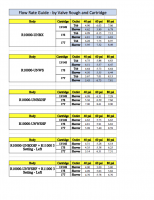dunstergirl
New Member
Getting ready to renovate the bathroom and want to find a good quality single-handle mixing/diverter valve that will give us good flow rates at the tub AND shower spouts (before shower head). I was very unhappy with the flow rates from the Moen I put in my last bathroom a couple of years ago.
We are completely redoing the plumbing so have the option of using either 3/4" or 1/2" pex to the installation from the main lines. I'm willing to spend the money on a more expensive valve if it gives the results we want. We're in Canada in case that makes a difference for codes, although we aren't terribly worried about that.
I would rather not go with more handles but would consider it if it makes a difference for flow.
Thank you for any advice.
Lelani
We are completely redoing the plumbing so have the option of using either 3/4" or 1/2" pex to the installation from the main lines. I'm willing to spend the money on a more expensive valve if it gives the results we want. We're in Canada in case that makes a difference for codes, although we aren't terribly worried about that.
I would rather not go with more handles but would consider it if it makes a difference for flow.
Thank you for any advice.
Lelani

